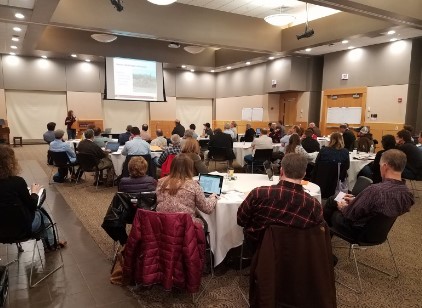By Lindsay Pease
The weather is warming up in the Red River Basin, and spring is finally here! As planning and prepping for field season continues, here is a quick look at what we at the
Northwest Research and Outreach Center have been up to on the research side.
Last month, 90 researchers and professionals from agriculture, engineering, and water resources management met at the University of Minnesota Crookston to discuss which agricultural Best Management Practices (BMPs) work best for reducing nutrient runoff. The
Nutrient Reduction BMP Workshop focused exclusively on the Red River Basin region, which begins in the northeast corner of South Dakota, cuts across northwest Minnesota and eastern North Dakota, and ends in the Canadian province of Manitoba at Lake Winnipeg. The diverse soils and cold climate in this region present unique challenges for managing soil, water, and nutrients. The goal of this workshop was to discuss what works, what doesn’t work, and what we don’t know yet.

Over the coming months, David Mulla (University of Minnesota) and David Whetter (AgriEarth Consulting) will write a technical report to synthesize the workshop’s findings and recommendations. This report will take a few months to complete, but in the meantime, here are my key takeaways on Nutrient Management BMPs in the Red River Basin:
Balancing nutrient application with crop needs is Step One in preventing nutrient loss
Nutrient management is one practice that every farmer should strive for when planning each year’s crop. Balancing nitrogen (N) and phosphorous (P) application with crop uptake isn’t a new concept, but it’s one basic step that makes economic sense as well as environmental sense.
Feed the crop, not the soil
The UMN Extension Nutrient Management Team’s long-term P trials tested the “feed-the-crop” concept using a replicated trial in five locations across the state of Minnesota. Results for Morris (near the southern end of the Red River Basin) and Crookston (in the central basin) agreed that soil test P levels in the “Medium” range (8 to 11 ppm Olsen-P) supply enough P for corn and soybean crops. What happens if soil test P is in the “high” or “very high” category? Chances of seeing a yield boost are unlikely. There is no yield advantage to a “build-and-maintain” approach compared to the “feed-the-crop” approach.
Use split application to get N rates right in corn
Jay Goos, a professor of soil science at North Dakota State University, discussed how residual soil N tends to be higher following corn than when following wheat or sugarbeets. The reason for this is simple: corn tolerates over-fertilization better than wheat or sugarbeets. Over-fertilizing wheat results in lodging. Over-fertilizing sugarbeets results in a lower-quality yield. According to Goos, the key to getting N fertilization right in corn is split application. Testing a one foot deep soil sample when corn is about one foot tall will help ensure that the right amount of N is on the field at the right time. The critical level of Nitrate-N is about 20-25 ppm.
If applying manure instead of commercial N fertilizer, UMN Extension educator Chryseis Modderman showed that split application is still an option. The UMN Manure Management Team is currently conducting field experiments to test if you can sidedress manure at the V4/V5 growth stage using a drag hose without causing permanent damage. Preliminary results show no yield loss from the drag hose.
Mitigating nutrient transport is Step Two in preventing nutrient loss
At the same time, nutrient management is not the only step in preventing nutrient loss. A low level of loss may be unavoidable, even if you follow recommended practices. For example, imagine a scenario where a heavy rainstorm interrupts you while you are broadcasting fertilizer. You have not had time to incorporate the fertilizer, so the very soluble fertilizer runs off with the stormwater. Regardless of your soil test levels, you will lose nutrients in that storm and it was unavoidable. After completing Step One, Step Two is mitigating nutrient transport in-field, at the edge-of-field, and downstream.
So what is Step Two?
Much of last month’s workshop focused on the nutrient transport BMPs that move beyond in-field nutrient management. Nutrient transport is challenging because nitrogen and phosphorus move through the soil in different ways. What works for nitrogen does not necessarily work for phosphorus. Plants and soils are dynamic. Sometimes they take up nutrients and sometimes they release nutrients.